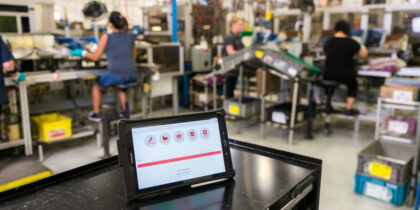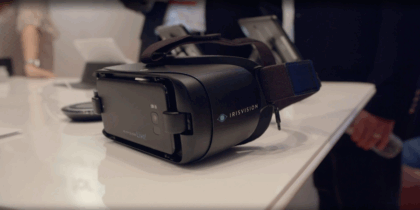Virtual reality (VR) experiences can be fun and exciting — but can they also be used effectively as an employee training method? Many organizations are already deploying VR training simulations, offering learners a chance to interact with content in new ways that aren’t possible in a traditional curriculum.
Training with VR can reduce costs, alleviate risks and allow employees to simulate tasks that could otherwise be too dangerous or cost-prohibitive to practice otherwise. Enterprises can create highly technical modules about sophisticated mechanical and technological processes — or extremely engaging video about customer and consumer interaction. It’s already being used in military applications, as well as to train customer service representatives, retail employees, first responders, healthcare professionals, machinery operators, drivers, sports teams and more.
Why VR for Training?
Aside from the flexibility of VR training simulations, there’s also a variety of long-term benefits to consider.
- It improves learning retention. The VR audience is beyond captive — they’re engaged. Putting the viewer in a VR headset eliminates almost all outside distractions. This can create a more memorable experience, helping users retain what they’ve learned.
-
It saves travel and personnel costs. When training is conducted in VR, organizations can save on the cost to fly employees out to training locations. One or more locations can be simulated in the VR environment, allowing easy exposure to a variety of settings. The trainers themselves can also be part of the VR programming — so you don’t have to hire instructors to train each new cohort, and you can repurpose those resources to more productive initiatives.
-
It also saves equipment run costs. Training employees to operate costly heavy machinery can always be a challenge, especially considering you may only have access to the equipment for a limited time, and you can only accommodate one trainee at a time on each machine. VR simulations can replicate these environments and machines for any number of trainees to experience.
-
It alleviates risk. In highly technical industries like healthcare and manufacturing, professionals can practice complicated procedures without risking lives. VR can also be used to simulate emergencies, fires and natural disasters to provide first responders with a realistic scenario before they have to apply what they’ve learned in the real world.
Interactive vs. Passive Content
When considering how your training content will be consumed, you’ll have to decide whether or not to include interactive elements. Interactivity can provide a much more engaging experience for the learner, but will also increase cost and time to produce training content.
A passive experience, such as an immersive 360 video, can often be more cost-effective and easier to produce. Passive experiences also don’t require sophisticated VR headsets tethered to powerful computers to operate. They can easily be watched in standard 360 video players that are freely available, and as a result, you can avoid application development costs. The downside is this results in a linear experience will be the same for every viewer.
An interactive experience can allow the employee to more fully engage with and even change the VR environment. However, hardware requirements may be more demanding. There will also be additional application development and animation costs. However, to simulate a true working environment, this level of interactivity may be necessary.
For a more hybrid experience, mobile phone based VR headsets such as the Samsung Gear VR offer a motion controller for navigation and interactions. Immersive 360 video content can be augmented with a UI, allowing the user to make selections or decisions throughout the experience. In other words, interactive and passive are not all-or-nothing options. Projects can be tailored to include a level of interaction to fit the needs of your training and your budget.
Creating and Distributing 360 Training Content
With a variety of 360 cameras available on the market, it may be easier than you think to produce 360 video content in-house. For organizations who need to create or update the curriculum on a regular basis, there can certainly be cost savings by producing in-house. Many 360 cameras today, such as the Samsung 360 Round, come with a suite of software to support the creation and distribution of content.
However, the initial equipment investment and the need for powerful editing workstations may be a hurdle for organizations who aren’t already creating high-end video content. If this poses a problem, or in those cases where production quality is absolutely vital, you might consider hiring a production company specializing in VR content. 360 cameras and production equipment can also be rented, which can lower costs for short-term projects. In addition, engines like Unity and Unreal provide developers with the building blocks to easily create a customized experience.
Distribution is easier than ever. There are several ready-made VR platforms for white-label 360 and interactive VR content. Some organizations may find it easy to handle the deployment of VR training entirely in-house.
Getting the Most Out of Training Results
VR makes it easy to measure the response of trainees. Heat maps show specifically where users look during a 360 experience, and instructors can even live monitor what users are seeing in the VR headset. Utilities such as ezVR allow organizations to simultaneously control training experiences across several Samsung Gear VR headsets from anywhere in the world.
Through VR app development, you can create applications that integrate with your existing Learning Management Systems (LMS). By having equipment in-house, you can continue to create, update and refresh training materials as your business needs change.
VR training presents a new and innovative way to cut costs, increase engagement, improve recall and provide employees with a valuable cutting-edge learning experience they will be excited to try. With all of the recent advancements in VR technology, the barriers to entry are quickly fading away, making it viable for just about any industry to jump into immersive training.
Ready to get started with your 360 content? Download our Ultimate Guide to 360 Video Production for more insights, from pre-production to post.







